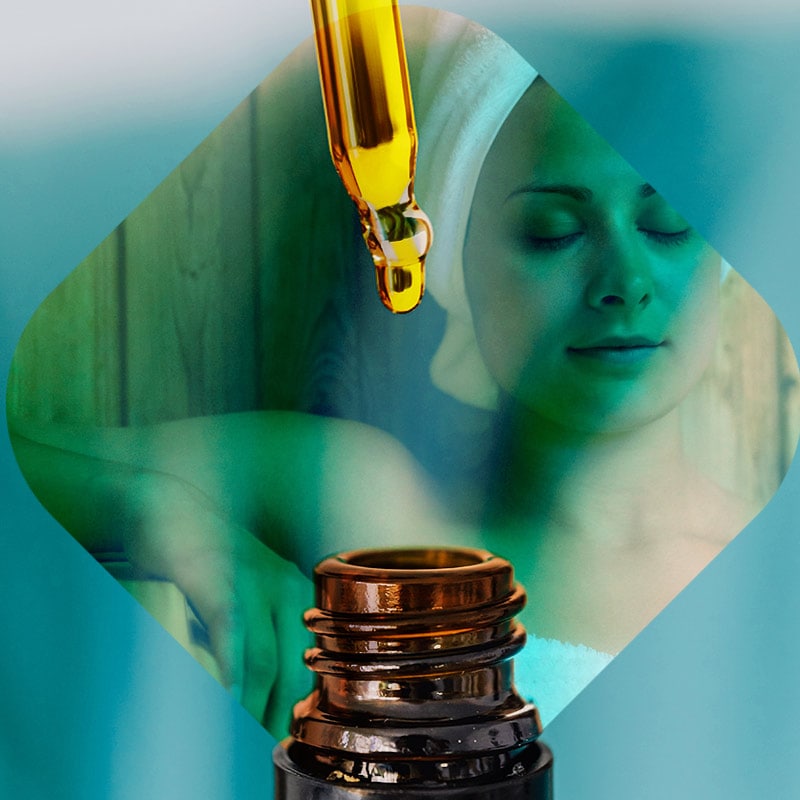For years, essential oils have been touted for their wonderful healing properties. They are described as stress relieving, calming, good for hair and skin, and uplifting beyond other things. In addition, they are antimicrobial. Many of the plants the oils are extracted from are known for their great medicinal properties. As a rule, essential oils should not be taken internally or used topically without proper dilution or formulation with other herbal agents. In continuance with the previous discussion of fungal overgrowth and the agents that support their reduction, this post will look at antifungal essential oils. These herbs work well with herbs discussed in 5 Herbal Agents for Antifungal Therapy. Here, we will investigate five extraordinary essential oils and their benefit in fighting fungal overgrowth.
Tea Tree Oil
Melaleuca alternifolia, a very common essential oil, is known as tea tree. This oil has been used for years as a topical antimicrobial agent. For good reason, as tea tree oil is full of antibacterial and antifungal properties. It has been shown to have efficacy against E. coli, S. aureus, Candida, and Aspergillus.
Topically, it is also effective in killing Trichophyton mentagrophytes, the organism that causes ringworm. This plant works by inhibiting fungal growth and by directly killing the fungi. It has the ability to penetrate the organisms’ cell wall and cytoplasmic membrane. This compromise leads to cellular death of the fungi and bacteria.
Its active compounds are alpha terpineol and terpene 4-alcohol. These compounds work to cause leakage of the cytoplasm, distortion of hyphae, and spore distortion. This wonderfully antimicrobial herb works well against different mold species. It has been shown effective in killing Aspergillus species and Penicillium most readily. This herb would make a great addition to any antifungal topical or oral rinse. Tea tree oil can be harmful if ingested and should be limited to topical usage unless carefully formulated with other herbs in an oral formula. In cases of topical fungal overgrowth, tea tree oil is essential. For mycotoxins, the use of tea tree is beneficial. Not only is it going to kill the mold that produces the toxin, but it will also directly inhibit mycotoxin activity. Tea tree is beneficial in inhibiting zearalenone (ZEA) and deoxynivalenol (DON).
Oregano Oil
This essential oil is derived from one of my favorite spices, oregano. Also known as Origanum vulgare, oregano, is a well-known, often utilized antimicrobial agent. With its active ingredients of carvacrol and thymol this herb’s active against various pathogens stands the test of time.
Oregano has been well researched in its efficacy against various bacteria. Some common bacteria it is effective against include Staph aureus, Salmonella, Bacillus cereus, Listeria, and Campylobacter. Orally, this plant is efficacious against thrush caused by candida albicans.
Along with its active ingredients of carvacrol, thymol, 4 terpineol work by inhibiting the candida phospholipase enzyme activity. This inhibition stops growth of the fungi and leads to their death. When it comes to mold, this herb works by inhibiting the growth of mold in a similar manner as candida. It is fungistatic and fungicidal. Its inhibitory effect works efficiently for Aspergillus, Penicillium and Fusarium species of mold. Carvone and p-cymene are other active ingredients that work with the carvacrol and thymol for its mold inhibitory effect. The target is the ergosterol of the fungal cell wall. This herb and cinnamon can reduce up to 83% of the ergosterol. Most of its inhibitory effect has been seen in relation to fungal growth and mycotoxin synthesis. It is most effective for blocking aflatoxin and fumonisin B1 toxins. This herb is a classic that will most likely continue to stand the test of time in treating fungal overgrowth.
Cinnamon Oil
The next herb is my absolute favorite. Cinnamon! Cinnamon is such a wonderful herb. It is an antioxidant, blood sugar regulating, antimicrobial plus has many other medicinal properties. Because of its medicinal and flavor profiles I find myself adding it to my tea, coffee, meals, and healthy desserts. Other than its flavoring enhancing powers, cinnamon is, in my opinion, an under used antimicrobial. Its active ingredients are cinnamaldehyde, cinnamyl acetate, and cinnamyl alcohol. They work together to inhibit growth of Bacillus species, E. coli, Pseudomonas, and MRSA. Cinnamaldehyde is the main aldehyde responsible for its antimicrobial properties in various ways. By inhibiting cell wall synthesis, membrane function, and enzymatic activity of the microorganism’s cinnamon exerts its fungicidal effect. There has also been evidence of biofilm disruption properties from this herb. The same effect is exhibited on various fungal species. Most notably are Aspergillus, Penicillium, Fusarium and Candida. When it comes to penicillium, cinnamon works by disrupting carbohydrate metabolism. Approximately 14 genes associated with fungal glycolysis, Krebs cycle, cellulose hydrolyzation, and the pentose phosphate shuttle are downregulated. There is also a decreased carb consumption and accumulation with a down regulated ATP production by the fungal organism. This is the mechanism in which cinnamon destroys this organism. It has similar effects on Aspergillus. The cinnamaldehyde works by downregulating the following genes of the mold: polyketide synthase (pks), nonribosomal peptide synthase (nrps), and velvet regulating proteins (veA, laeA, and velB). These are needed for biosynthetic and regulatory processes for sustaining fungal life. They regulated the cell wall and plasma membrane synthesis, mitochondrial and other intracellular organelle presence and function. The pks and nrps genes along with cytochrome p450 monooxygenase and halogenase enzymes regulate ochratoxin A production. The velvet regulating proteins coordinate fungal development and secondary metabolism that can also lead to OTA production. Due to the multiple properties of cinnamaldehyde it not only kills the fungal organism but also downregulates the production of OTA before the organism is destroyed. The action against Fusarium mold is similar. It works by inhibiting mycelial growth and mycotoxin production by causing cytoplasmic leakage. The direct antioxygenic effects work on the following toxins: OTA, Aflatoxin B1 (AFB1), DON, ZEA, Fumonisin b1. These properties make cinnamon a great addition in any anti mold or anti-bacterial protocol.
Eucalyptus Oil
Another commonly used essential oil is Eucalyptus. Many species of eucalyptus are antimicrobial. Globulus, citrodora, and camaldulensis are common species. Commonly this herb is used for its calming effect and in nasal inhalations for sinusitis. The great benefit of this is that chronic sinusitis is one of the most common symptoms of mold exposure. Other common symptoms and conditions associated with antimicrobial overgrowths are keratitis, conjunctivitis, and other allergy symptoms. Eucalyptus has been shown effective in treating allergic type symptoms. Along with other essential oils like lemongrass this herb is a beneficial addition for those with allergies and upper respiratory conditions. This herb has shown efficacy along with tea tree oil in treating Fusarium keratitis. Dermophytes like, Trichophyton, are also affected by this oil. Eradication by topical application to nail and skin fungal overgrowths have been documented as well. The actual antimicrobial mechanism, unfortunately, is not very well studied. The active ingredients of eucalyptus oil are 1,8-cineole, limonene, p-cymene, γ-terpinene, α-pinene, α-terpineol, camphene, linalool, and ocimene. 1,8 cineole is the most active. Of the volatile component of the oil, up to 75-95% can be active antimicrobial components. This makes this oil very potent. The mechanism of action is thought to be due its targeting of the cytoplasmic membrane integrity leading to impair cell stability and permeability. This causes cellular leakage ultimately killing the organism. In a study that looked at the antimicrobial activity against Staph, Pseudomonas, Klebsiella, and Candida albicans. This study showed that while the extracted 1,8 cineole was beneficial in killing these organisms, most were better addressed with the crude essential oil rather than the extract alone. This shows us that the whole plant is necessary for the full antimicrobial punch that it packs. Another compound found in eucalypts is eucarobustol E. The compound works by inhibiting the yeast to hyphal transformation, causing a reduction of the hydrophobicity of the biofilm, making it more susceptible. It does this by inhibiting genes required for hyphal synthesis which include: EFG1, CPH1, TEC1, EED1, UME6, and HGC. The other way eucarobustol E works is downregulating genes involved in ergosterol synthesis. Ergosterol is the main fungal sterol that gives cell membranes their integrity. It is the cholesterol of the fungal world. The inhibition of this sterol is another way that the fungal cell is destroyed.
Lemongrass Oil
The last essential oil on the list is lemongrass. Sometimes confused with lemon oil, which is extracted from the peel of lemon, lemongrass comes from a type of grass. Also known as Cymbopogon citratus, lemongrass is a commonly used essential oil. Its properties include antibacterial, antidiarrheal, cholesterol reducing, hypoglycemic, sedative, hypnotic, antifungal, and anti-inflammatory. This herb is full of active ingredients. They range from flavonoids and phenolic compounds to ketones and aldehydes. Specific constituents are luteolin, isoorientin2’-O-rhamnoside, quercetin, kaempferol, and apigenin to phytonutrients like citral alpha and beta, nerol geraniol, citronellal, terpineol, limonene, myrcene, and methylheptenone. The alpha and beta citral are what makes it antibacterial. These constituents work together to disrupt and inhibit the growth of fusarium mold. Due to this disruption it also works to block the biosynthesis of mycotoxins. When it comes to candida, lemongrass works to down regulate hyphal adhesion and the virulent factors candida possesses. It is also effective against Staph aureus. Against staph, lemongrass works by inhibiting the gene expression of quorum sensing peptidoglycan and fatty acid biosynthesis. In addition, it has been shown effective in treating aspergillus orally. Another action of attack is its effect as a biofilm disruptor. No matter what the bacterial or fungal overgrowth your patient would benefit with the addition of lemongrass.
To wrap things up, natural agents can play a giant part in the correction of microorganism overgrowth. Whether they be your main treatment, adjunct to prescriptions, or even a nice topical support for dermal fungal overgrowths. Tea tree, oregano, cinnamon, eucalyptus, and lemongrass are great essential oils to begin with. Do not forget these other honorable mention essential oils: thyme, clove, lavender, clary sage, coriander, basil, rosemary, peppermint, anise, ginger, and sage. With positive OAT mold and yeast markers and positive MycoTOX Profile, these herbs make great additions to treatment. Many formulations take advantage of the antimicrobial nature of these herbs.
Mycotoxins (toxins from mold) are some of the most prevalent toxins in the environment. Mycotoxins are metabolites produced by fungi like mold, which can infest buildings, vehicles, and foodstuffs.
Our primary goals for this test were to design a test that would be more sensitive and accurate as well as more affordable than those currently on the market. We were able to achieve these goals with our state-of-the-art liquid chromatography mass spectrometry (LC-MS/MS) technology. Using this technology, we have a very sensitive test, which is important because mycotoxins can cause serious health issues even in small quantities.
References1. Boukhatem MN; Ferhat MA; Kameli A; Saidi F;Kebir HT;. (n.d.). Lemon grass (cymbopogon citratus) essential oil as a potent anti-inflammatory and antifungal drug. Retrieved March 12, 2021, from SOURCE.
2. Brochot A; Guilbot A; Haddioui L; Roques. (n.d.). Antibacterial, antifungal, and antiviral effects of three essential Oil blends. Retrieved March 12, 2021, from SOURCE.
3. Concha, J., Moore, L., & Holloway, W. (1998, October 01). 1998 William J. Stickel Bronze Award. antifungal activity of Melaleuca ALTERNIFOLIA (TEA-TREE) oil against various pathogenic organisms. Retrieved March 12, 2021, from SOURCE.
4. Elaissi A; Rouis Z; Salem NA;Mabrouk S;ben Salem Y;Salah KB;Aouni M;Farhat F;Chemli R;Harzallah-Skhiri F;Khouja ML;. (n.d.). Chemical composition of 8 eucalyptus SPECIES' essential oils and the evaluation of Their antibacterial, antifungal and Antiviral activities. Retrieved March 12, 2021, from SOURCE.
5. Elaissi A; Rouis Z; Salem NA;Mabrouk S;ben Salem Y;Salah KB;Aouni M;Farhat F;Chemli R;Harzallah-Skhiri F;Khouja ML;. (n.d.). Chemical composition of 8 eucalyptus SPECIES' essential oils and the evaluation of Their antibacterial, antifungal and Antiviral activities. Retrieved March 12, 2021, from SOURCE.
6. Fürst, R., Luong, B., Thomsen, J., & Wittig, T. (2019). ELOM-080 as Add-on treatment for respiratory tract Diseases – a review of clinical studies conducted in China. Planta Medica, 85(09/10), 745-754. doi:10.1055/a-0942-1993
7. Gao S; Liu G; Li J;Chen J;Li L;Li Z;Zhang X;Zhang S;Thorne RF;Zhang S;. (n.d.). Antimicrobial activity Of LEMONGRASS essential oil (Cymbopogon Flexuosus) and its active Component citral AGAINST Dual-Species biofilms of Staphylococcus aureus and CANDIDA SPECIES. Retrieved March 12, 2021, from SOURCE.
8. Gao S; Liu G; Li J;Chen J;Li L;Li Z;Zhang X;Zhang S;Thorne RF;Zhang S;. (n.d.). Antimicrobial activity Of LEMONGRASS essential oil (Cymbopogon Flexuosus) and its active Component citral AGAINST Dual-Species biofilms of Staphylococcus aureus and CANDIDA SPECIES. Retrieved March 12, 2021, from SOURCE.
9. Gemeda, N., Woldeamanuel, Y., Asrat, D., & Debella, A. (2014). Effect of essential oils on aspergillus spore germination, growth and mycotoxin production: A potential source of botanical food preservative. Asian Pacific Journal of Tropical Biomedicine, 4. doi:10.12980/apjtb.4.2014c857
10. Ghasemian A; Eslami M; Hasanvand F;Bozorgi H;Al-Abodi HR;. (n.d.). Eucalyptus camaldulensis properties for use in the eradication of infections. Retrieved March 12, 2021, from SOURCE.
11. GÓMEZ-SÁNCHEZ, A., PALOU, E., & LÓPEZ-MALO, A. (2011). Antifungal activity evaluation of Mexican Oregano (LIPPIA berlandieri Schauer) essential oil on the growth OF Aspergillus flavus by GASEOUS CONTACT. Journal of Food Protection, 74(12), 2192-2198. doi: 10.4315/0362-028x.jfp-11-308
12. Homa M; Fekete IP; Böszörményi A;Singh YR;Selvam KP;Shobana CS;Manikandan P;Kredics L;Vágvölgyi C;Galgóczy L;. (n.d.). Antifungal effect of essential oils against fusarium keratitis isolates. Retrieved March 12, 2021, from SOURCE.
13. J; G. (n.d.). A novel niosome-encapsulated essential oil formulation to prevent aspergillus flavus growth and aflatoxin contamination of maize grains during storage. Retrieved March 12, 2021, from SOURCE.
14. Kocic-Tanackov, S., Dimic, G., Tanackov, I., Pejin, D., Mojovic, L., & Pejin, J. (2012). Antifungal activity of Oregano (Origanum vulgare L.) extract on the growth of FUSARIUM and penicillium species isolated from food. Chemical Industry, 66(1), 33-41. doi:10.2298/hemind110614073k
15. Kong Q; Zhang L; An P;Qi J;Yu X;Lu J;Ren X;. (n.d.). Antifungal mechanisms of α-terpineol AND terpene-4-alcohol as the critical components of Melaleuca alternifolia oil in the inhibition of rot disease caused by Aspergillus Ochraceus in POSTHARVEST GRAPES. Retrieved March 12, 2021, from SOURCE.
16. Kozics K; Bučková M; Puškárová A;Kalászová V;Cabicarová T;Pangallo D;. (n.d.). The effect of ten essential oils on several cutaneous drug-resistant microorganisms and their cyto/genotoxic and antioxidant properties. Retrieved March 12, 2021, from SOURCE.
17. Lai T; Sun Y; Liu Y;Li R;Chen Y;Zhou T;. (n.d.). Cinnamon oil Inhibits Penicillium Expansum growth by disturbing the CARBOHYDRATE metabolic process. Retrieved March 12, 2021, from SOURCE.
18. Lai Y; Dilidaer D; Chen B;Xu G;Shi J;Lee RJ;Cohen NA;. (n.d.). In vitro studies of a distillate of rectified essential oils on sinonasal components of mucociliary clearance. Retrieved March 12, 2021, from SOURCE.
19. Li WR; Li HL; Shi QS;Sun TL;Xie XB;Song B;Huang XM;. (n.d.). The dynamics and mechanism of the antimicrobial activity of tea tree oil against bacteria and fungi. Retrieved March 12, 2021, from SOURCE.
20. Liu RH; Shang ZC; Li TX;Yang MH;Kong LY;. (n.d.). In vitro antibiofilm activity of eucarobustol e against candida albicans. Retrieved March 12, 2021, from SOURCE.
21. Liu RH; Shang ZC; Li TX;Yang MH;Kong LY;. (n.d.). In vitro antibiofilm activity of eucarobustol e against candida albicans. Retrieved March 12, 2021, from SOURCE.
22. Liu, Q., Meng, X., Li, Y., Zhao, C., Tang, G., & Li, H. (2017, June 16). Antibacterial and antifungal activities of spices. Retrieved March 12, 2021, from SOURCE.
23. Pradebon Brondani L; Alves da Silva Neto T; Antonio Freitag R;Guerra Lund R;. (n.d.). Evaluation of anti-enzyme properties of Origanum vulgare essential oil Against oral Candida albicans. Retrieved March 12, 2021, from SOURCE.
24. Puškárová, A., Bučková, M., Kraková, L., Pangallo, D., & Kozics, K. (2017, August 15). The antibacterial and antifungal activity of six essential oils and THEIR Cyto/genotoxicity to Human Hel 12469 CELLS. Retrieved March 12, 2021, from SOURCE.
25. Sahal G; Woerdenbag HJ; Hinrichs WLJ;Visser A;Tepper PG;Quax WJ;van der Mei HC;Bilkay IS;. (n.d.). Antifungal and BIOFILM inhibitory effect OF CYMBOPOGON citratus (lemongrass) essential oil on Biofilm forming BY Candida TROPICALIS Isolates; an in vitro study. Retrieved March 12, 2021, from SOURCE.
26. Shah, G., Shri, R., Panchal, V., Sharma, N., Singh, B., & Mann, A. (2011, January). Scientific basis for the therapeutic use OF CYMBOPOGON citratus, STAPF (lemon grass). Retrieved March 12, 2021, from SOURCE.
27. Tolba H; Moghrani H; Benelmouffok A;Kellou D;Maachi R;. (n.d.). Essential oil of Algerian Eucalyptus CITRIODORA: Chemical composition, antifungal activity. Retrieved March 12, 2021, from SOURCE.
28. TV; H. (n.d.). In vitro activity of Melaleuca ALTERNIFOLIA (TEA tree) oil against dermatophytes and OTHER filamentous fungi. Retrieved March 12, 2021, from SOURCE.
29. Utchariyakiat, I., Surassmo, S., Jaturanpinyo, M., Khuntayaporn, P., & Chomnawang, M. (2016, June 1). Efficacy of cinnamon bark oil and cinnamaldehyde on anti-multidrug resistant pseudomonas aeruginosa and the synergistic effects in combination with other antimicrobial agents. Retrieved March 12, 2021, from SOURCE.
30. Utchariyakiat, I., Surassmo, S., Jaturanpinyo, M., Khuntayaporn, P., & Chomnawang, M. (2016, June 1). Efficacy of cinnamon bark oil and cinnamaldehyde on anti-multidrug resistant pseudomonas aeruginosa and the synergistic effects in combination with other antimicrobial agents. Retrieved March 12, 2021, from SOURCE.
31. Velluti, A., Sanchis, V., Ramos, A., Egido, J., & Marı́n, S. (2003, April 25). Inhibitory effect of cinnamon, clove, lemongrass, oregano and palmarose essential oils on growth and fumonisin b1 production by fusarium proliferatum in maize grain. Retrieved March 12, 2021, from SOURCE.
32. Wan J; Zhong S; Schwarz P;Chen B;Rao J;. (n.d.). Physical properties, antifungal and mycotoxin INHIBITORY activities of five essential oil nanoemulsions: Impact of OIL compositions and Processing parameters. Retrieved March 12, 2021, from SOURCE.
33. Wan J; Zhong S; Schwarz P;Chen B;Rao J;. (n.d.). Physical properties, antifungal and mycotoxin INHIBITORY activities of five essential oil nanoemulsions: Impact of OIL compositions and Processing parameters. Retrieved March 12, 2021, from SOURCE.
34. Wang GS; Deng JH; Ma YH;Shi M;Li B;. (n.d.). Mechanisms, clinically curative effects, and antifungal activities of Cinnamon oil and POGOSTEMON OIL complex against three species of Candida. Retrieved March 12, 2021, from SOURCE.
35. Wu D; Lu J; Zhong S;Schwarz P;Chen B;Rao J;. (n.d.). Influence of nonionic and ionic surfactants on the antifungal and mycotoxin inhibitory efficacy of cinnamon oil nanoemulsions. Retrieved March 12, 2021, from SOURCE.
36. X; T. (n.d.). Repellent, insecticidal and Antimicrobial activities of LEAF essential oils from Three Eucalyptus species. Retrieved March 12, 2021, from SOURCE.
37. Zhou, L., Li, F., Huang, L., Yang, Z., Yuan, S., & Bai, L. (2016, May 12). Antifungal activity of eucalyptus oil against rice blast fungi and the possible mechanism of gene expression pattern. Retrieved March 12, 2021, from SOURCE.




